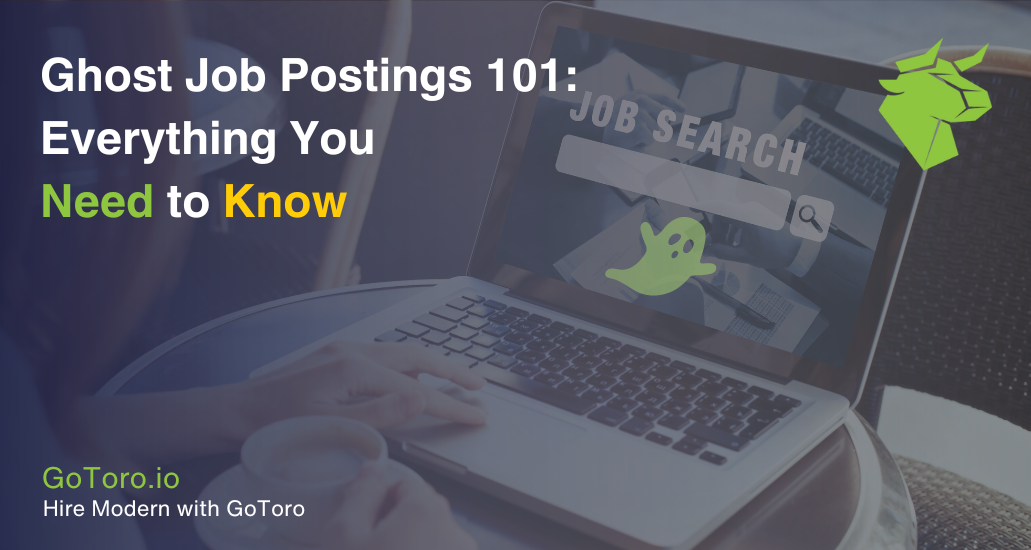In today’s fast-paced job market, it’s not uncommon for job seekers to come across positions that seem too good to be true. But what if those positions never actually existed? Welcome to the world of ghost job postings—a puzzling phenomenon where companies advertise jobs that aren’t meant to be filled, or at least not anytime soon. This blog will take you behind the scenes of ghost job postings, exploring what they are, why they exist, and what both employers and job seekers need to know about this practice
What Are Ghost Job Postings and How Common Are They?

Definition of Ghost Job Postings
Ghost job postings refer to job advertisements for positions that don’t actually exist or are not intended to be filled immediately. These listings can appear in various forms, from completely fictitious roles to outdated job openings that remain posted long after the position has been filled. Companies may create these for several reasons, often related to data collection or maintaining a competitive edge.
Purpose of Ghost Job Postings
The primary purpose behind ghost job postings varies depending on the company’s goals. Some businesses use these postings as a tool for gathering market data, such as assessing the availability of talent with specific skills or qualifications. This information can be invaluable in helping organizations plan future hiring strategies or adjust their recruitment efforts based on current market conditions.
Additionally, companies may use these postings to assess the talent pool. By keeping certain positions posted, they can continuously collect resumes and build a database of potential candidates for when a real position opens up. This approach can be particularly useful in industries where specific skills are in high demand, and the company wants to be ready to act quickly when a vacancy occurs.
Another reason is to maintain the appearance of growth. In competitive industries, a steady stream of job postings can signal to the market, investors, and even competitors that the company is expanding or thriving. This perception of growth can be strategic in positioning the company as a leader in its field.
Prevalence of Ghost Job Postings
While the exact prevalence of ghost job postings is challenging to determine, they are not uncommon in the hiring landscape. This practice is particularly prevalent in highly competitive industries, such as technology, finance, and healthcare, where companies are keen to stay informed about labor market trends or competitors’ recruitment strategies.
In some cases, ghost job postings may make up a significant portion of a company’s total job advertisements, especially during times of economic uncertainty or rapid industry changes. However, the lack of transparency around the intent behind these postings makes it difficult for job seekers to distinguish between genuine opportunities and ghost listings.
Recent research highlights this increasing trend. In a survey of over 1,000 hiring managers, 68% revealed that they keep job postings live for more than 30 days. Additionally, 10% admitted to having job openings posted for over six months. When asked why they aren’t urgently filling these positions, the top three reasons cited were:
- Staying open to new talent
- Motivating current employees
- Projecting an image of company growth
The Historical Context of Ghost Job Postings
Evolution of Ghost Job Postings
The practice of ghost job postings has evolved significantly with changes in technology, recruitment practices, and the overall job market. Historically, companies might have posted job ads in newspapers or industry journals, even when they weren’t actively hiring, to maintain visibility and attract potential candidates. However, the digital age has amplified this practice, making it easier for companies to post and maintain ghost job listings across multiple online platforms.
With the rise of job boards, company career pages, and social media, ghost job postings have become more widespread. These platforms allow companies to post job openings with minimal effort and cost, keeping positions visible to a global audience. The use of applicant tracking systems (ATS) has further streamlined the process, enabling businesses to collect and store resumes for future use without actively engaging with candidates.
As recruitment practices have become more data-driven, the strategic use of ghost job postings has also evolved. Companies now have access to sophisticated analytics tools that can track the performance of job postings, gather insights on applicant behavior, and refine their hiring strategies based on real-time data.
Impact of Economic Conditions on Ghost Job Postings
Economic conditions play a significant role in the prevalence of ghost job postings. During economic downturns or periods of uncertainty, companies may be more inclined to use these as a way to monitor the labor market without committing to new hires. This allows businesses to stay informed about the availability of talent and be prepared to act quickly when economic conditions improve.
Conversely, during economic booms, companies may use these to create the perception of rapid growth and expansion. This can help attract investors, enhance the company’s reputation in the industry, and position the business as a desirable employer, even if the actual hiring needs are not as extensive as the job postings suggest.
Overall, the evolution of ghost job postings reflects broader changes in the recruitment landscape, influenced by technological advancements and economic factors. While these postings can serve various strategic purposes for companies, they also raise ethical questions and challenges for job seekers navigating the modern job market.
Perks and Cons of Ghost Job Postings for Data Collection
Ghost job postings serve as a double-edged sword in the realm of data collection for companies. While they can provide valuable insights and strategic advantages, they also come with significant risks and downsides. Below, we explore the perks and cons of using ghost job postings for data collection.
Perks for Data Collection
Market Research:
Ghost job postings can be an effective tool for market research. By posting fictitious or non-urgent job listings, companies can gauge the demand for specific skills, qualifications, and experiences within the job market. This information helps businesses understand which roles are in high demand, the availability of talent, and potential salary expectations. Armed with this data, companies can make more informed decisions when planning their future recruitment strategies.
Competitive Analysis:
In highly competitive industries, ghost job postings can offer valuable insights into how competitors are attracting talent. By monitoring the response to these postings, companies can analyze what benefits, salaries, or perks are appealing to candidates and how these factors compare to their own offerings. This information allows businesses to refine their job descriptions and compensation packages to remain competitive in the market.
Talent Pipeline Building:
One of the most practical uses of ghost job postings is in building a talent pipeline. Even if the position isn’t immediately available, companies can collect resumes and assess potential candidates for future roles. This proactive approach enables businesses to quickly fill positions when they do become available, reducing time-to-hire and ensuring that a pool of qualified candidates is readily accessible.
Trend Identification:
Ghost job postings can also help identify emerging job trends, skill gaps, and popular job titles within the industry. By analyzing the responses to these postings, companies can detect shifts in the job market, such as new skills becoming increasingly important or certain job titles gaining popularity. This knowledge allows businesses to stay ahead of industry trends and adjust their hiring strategies accordingly.
Data-Driven Decisions:
The data collected from ghost job postings can be instrumental in making data-driven decisions. This includes refining job descriptions, optimizing recruitment strategies, and tailoring benefits packages to better align with market expectations. By leveraging this data, companies can improve their overall hiring process and ensure that they are attracting the right talent.
Cons for Data Collection
Deceptive Practices:
One of the most significant downsides of ghost job postings is the potential for candidates to feel misled or deceived. If job seekers discover that the posting wasn’t for a real position, it can erode their trust in the company. This deception can lead to negative perceptions of the company and potentially deter qualified candidates from applying to future job openings.
Wasted Resources:
Reviewing applications and resumes for non-existent positions can be a drain on HR resources. Time and effort spent on ghost job postings might divert attention away from actual hiring needs, leading to inefficiencies within the recruitment process. This wasted effort can be particularly detrimental to smaller companies with limited HR capacity.
Negative Employer Branding:
If it becomes known that a company frequently uses ghost job postings, it can harm its employer brand. Candidates and industry peers may view the company as untrustworthy or manipulative, which can deter top talent from considering the company as a potential employer. A damaged reputation can take time to repair and may require significant efforts to rebuild trust with job seekers.
Legal and Ethical Concerns:
The use of ghost job postings raises potential legal and ethical concerns. In some jurisdictions, there may be regulations against posting fictitious job listings, especially if they are deemed misleading or fraudulent. Even in the absence of legal repercussions, the ethical implications of misleading job seekers can result in long-term damage to the company’s reputation and relationships with candidates.
Skewed Data:
Finally, the data collected from ghost job postings might not always be reliable. Some candidates may choose not to apply to these postings if they suspect the job isn’t real, leading to an incomplete or skewed dataset. This can result in inaccurate conclusions about the talent pool, making it difficult for companies to make truly informed decisions based on the collected data.
The Candidate Experience

How Candidates Perceive Ghost Job Postings
For job seekers, encountering ghost job postings can lead to a range of negative emotions and experiences. One of the most common reactions is frustration. Candidates invest time and effort into tailoring their resumes, writing cover letters, and preparing for potential interviews, only to find that the position they applied for doesn’t actually exist or was never intended to be filled. This can be particularly disheartening for those who are actively seeking employment and may feel that their time has been wasted.
Moreover, the discovery of ghost job postings can foster skepticism about the hiring process as a whole. When candidates encounter multiple ghost postings, they may begin to question the authenticity of other job listings, leading to a lack of trust in employers and the recruitment process. This skepticism can extend to the company’s brand, damaging its reputation among job seekers and potentially reducing the pool of qualified candidates who are willing to apply for legitimate positions.
In extreme cases, repeated encounters with ghost job postings can contribute to a sense of disillusionment with the job search process. Candidates may feel that they are being manipulated or used for purposes other than genuine hiring, which can erode their confidence in the fairness and transparency of the job market.
How to Identify a Ghost Job Posting

There are several red flags that can help candidates identify potential ghost job postings:
- Vague or generic job descriptions. These posts often feature job descriptions that lack specific details about the role, responsibilities, or required qualifications. If the job description seems too broad or could apply to a wide range of positions, it may be a ghost posting.
- No clear timeline. If the job posting does not specify a clear timeline for the hiring process, such as application deadlines, interview schedules, or start dates, it could be a sign that the position isn’t intended to be filled immediately.
- Persistent or unchanging listings. Ghost job postings may remain on job boards for an extended period without any changes to the listing. If a job has been posted for several months without updates or new information, it could be a ghost listing.
- Lack of contact information. Authentic job postings typically include contact information for the recruiter or hiring manager. If the posting lacks any contact details or only provides a generic email address, it may be a ghost job.
- Overly positive company descriptions. While companies often promote their strengths, a job posting that focuses excessively on the company’s image or growth, without much detail about the actual role, could be a ghost job designed to create a positive impression rather than fill a position.
By being vigilant and looking for these signs, candidates can reduce the likelihood of applying to ghost job postings and focus their efforts on genuine opportunities.
Alternatives to Ghost Job Postings
Ethical Alternatives
Companies looking to gather market data or build a talent pipeline without resorting to ghost job postings have several ethical alternatives at their disposal:
- Conducting surveys and market research. Instead of using fictitious job listings, companies can conduct surveys or market research studies to gather data on the job market. This approach can provide valuable insights into candidate availability, salary expectations, and in-demand skills without misleading job seekers.
- Engaging with talent communities. Building and engaging with talent communities is another ethical way to stay informed about market trends and potential candidates. Companies can create forums, social media groups, or email newsletters to connect with industry professionals and gather insights from real interactions.
- Leveraging third-party data sources. Numerous third-party data sources and analytics platforms offer comprehensive information on job market trends, competitor analysis, and candidate behavior. Companies can subscribe to these services to gain the insights they need without creating ghost job postings.
Transparent Recruitment Practices
Adopting transparent recruitment practices is essential for maintaining trust and integrity with potential employees. Companies should strive to:
- Clearly communicate hiring intentions. Be upfront about the nature of job postings. If a position is posted to gather resumes for future openings, clearly state that in the job description. Transparency about the hiring process helps build trust with candidates.
- Provide regular updates. Keep job postings up to date with any changes in the hiring process or timeline. Regular communication with candidates, even if there are no immediate openings, can help maintain a positive relationship and prevent frustration.
- Avoid posting non-existent roles. Companies should avoid posting jobs that don’t exist purely for data collection purposes. If the goal is to gather market data, alternative methods such as surveys or research reports should be used instead.
By embracing these ethical and transparent practices, companies can achieve their recruitment goals without compromising their reputation or the candidate experience.
Legal and Ethical Implications
Deeper Dive into Legal Risks
The use of ghost job postings can carry significant legal risks, particularly in jurisdictions with strict employment regulations. In some regions, posting fictitious job listings may be considered misleading or fraudulent, potentially resulting in legal action against the company. For example, if a candidate applies for a ghost job posting and later discovers that the position was never real, they may have grounds to file a complaint with labor authorities or pursue legal action for misrepresentation.
Additionally, if a company uses ghost job postings to collect personal data from candidates, it must ensure compliance with data protection laws such as the General Data Protection Regulation (GDPR) in Europe. Failing to handle candidate data properly can lead to severe penalties and damage to the company’s reputation.
Industry Guidelines or Best Practices
To mitigate the risks associated with ghost job postings, companies should adhere to industry guidelines and best practices for advertising. These guidelines often emphasize the importance of transparency, honesty, and fairness in the recruitment process. For example:
- Follow employment advertising standards. Adhere to advertising standards that require job postings to be truthful and not misleading. This includes ensuring that all listed positions are real and actively being recruited for.
- Implement clear data privacy policies. Companies should have clear policies in place regarding the collection, storage, and use of candidate data. These policies should be communicated to candidates in the job posting or during the application process.
- Engage in ethical recruitment practices. Ethical recruitment practices involve being honest about job openings, respecting candidate time and effort, and avoiding deceptive tactics to gather market data or resumes.
By following these guidelines and best practices, companies can reduce the legal and ethical risks while maintaining a positive reputation in the job market.
In conclusion, while ghost job postings can offer companies valuable insights and strategic advantages, they also come with significant risks that can impact both candidates and employer branding. By adopting ethical alternatives and transparent recruitment practices, companies can achieve their hiring goals without compromising trust or integrity. If you’re looking to enhance your recruitment strategies with data-driven insights and effective solutions, request a demo from GoToro today and discover how we can help you attract and retain top talent in a competitive job market.


